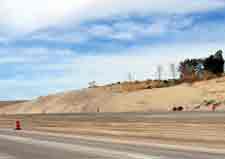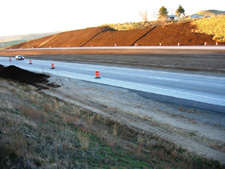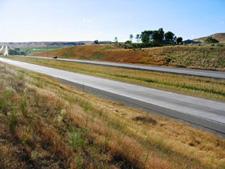Improving Highway Safety Through Erosion Control
Erosion Control Through Revegetation
EPA530-F-05-014
August 2005

Until recently, a typical sustained wind could shut down a stretch of Interstate 84 in Glenns Ferry, Idaho. Blowing sand from the steep sandy slope next to the highway reduced visibility, creating dangerous driving conditions. Traditional erosion control methods had failed, and the Idaho Transportation Department (ITD) had to wet down the slope whenever potentially hazardous conditions existed. ITD needed a long-term solution.
GreenCover America, Inc. hoped its organic and environmentally friendly compost-based erosion control techniques would solve the problem. Using an “erosion blend” compost from Utah-based Miller Companies, LC, GreenCover America’s compost blankets and berms aim to control erosion through complete and rapid revegetation. The compost blend combines ingredients such as animal manure, wastewater sludge, ground forest slash, and other wood fiber products. “GreenCover America is not just laying a simple manure-based compost,” says Jeff Burns, co-owner of GreenCover America, “but actually amending the soil with an organically rich growing medium.” This allows native plant species to thrive for many years to come.

After compost blanket installation
With the compost blanket, the compost blend is pneumatically installed using a blower truck on the existing subsoil. Moisture and nutrients in the compost blend mix with the subsoil to improve its condition and ability to sustain growth. In the Glenns Ferry project, GreenCover America laid a 2-inch deep compost blanket with 11 native seed species and one cold cover crop to rapidly germinate the slope in the fall of 2004. Within 4 months, shin-deep grass covered the entire area and stabilized the slope. GreenCover America injects seeds, such as native grasses, wildflowers, shrubs, and sage brush, directly into the compost blanket and adds a performance enhancing additive for nutrients and to help the blend stick together. Because compost blankets and berms contain no plastic or any other artificial products, there is nothing to remove from the site after application.

Early seed germination on I-84
After two previous ITD attempts failed to control erosion at the Glenns Ferry site, GreenCover America’s technique was successful. “We’re proud that we accomplished something that’s vitally important—keeping the highway open and safe,” says Burns. And, if the seeds had not taken root, GreenCover America would have tried again. The company has a guarantee policy and has thus far achieved a success rate between 90 and 100 percent in all its projects after the initial application. Such techniques have proved extremely successful in the western part of the United States and other arid climates, where the compost acts as a sponge, retaining the little moisture available from nature.
Burns learned there is a common misconception about compost; some people think compost is entirely comprised of animal waste (i.e., manure) with high nitrogen levels that will eventually kill any new growth. Before the Glenns Ferry project, people expressed uncertainty about the feasibility of growing anything in a sterile, sandy environment. But successful projects like Glenns Ferry and others in Idaho, Wyoming, and Illinois have allowed GreenCover America to show the skeptics what can be accomplished. Burns expects future projects to benefit greatly from the work the company has already completed.

Full germination of native grasses
Burns sees many opportunities for company growth—GreenCover America started with landfill cover projects and quickly moved into the highway construction field. Now, Burns and his colleagues are looking at mine reclamation applications, forest fire-burn area restoration, and even potential uses at ski resorts.
View and print this fact sheet (PDF) (2 pp, 121K, about PDF)
Disclaimer: Reference herein to any specific commercial products, process, or service by trade name, trademark, manufacturer, or otherwise, does not necessarily constitute or imply its endorsement, recommendation, or favoring by the United States Government. The views and opinions of authors expressed herein do not necessarily state or reflect those of the United States Government, and shall not be used for advertising or product endorsement purposes.
![[logo] US EPA](../gif/logo_epaseal.gif)